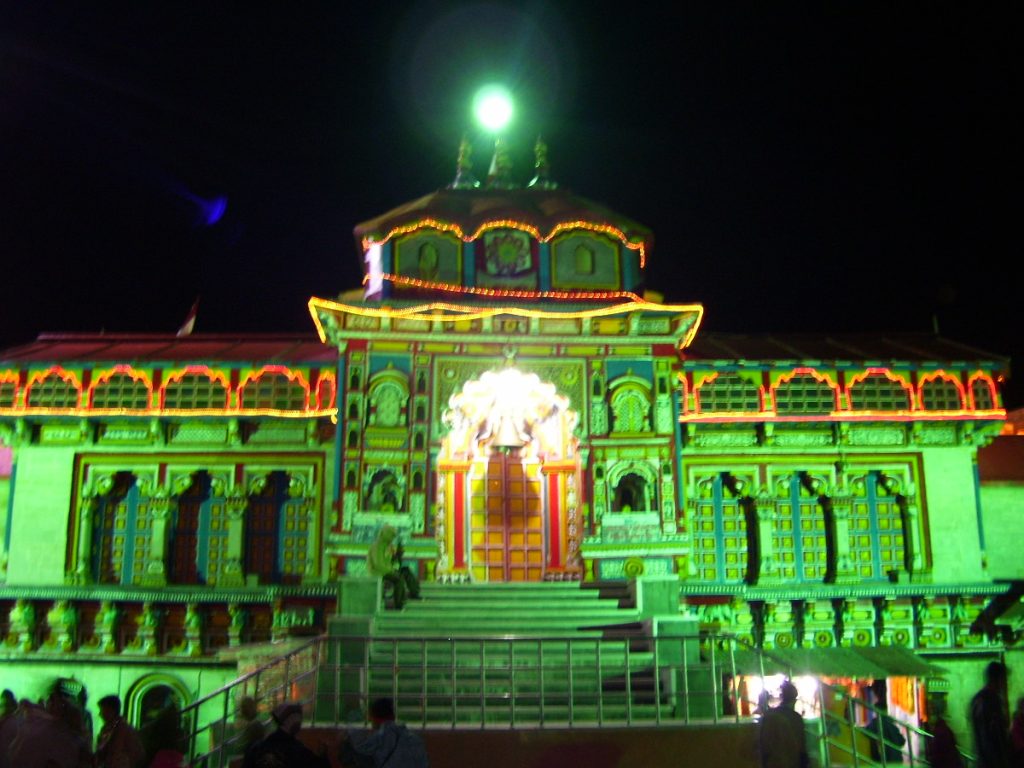Badrinath is one of the holiest Hindu temples in the Indian Subcontinent. It’s dedicated to the god Vishnu. This temple and town are one of the four Char Dham and Chota Char Dham pilgrimage sites. It is also one of the 108 Divya Desams, a set of holy shrines for Vaishnavites.
Shrine’s History
First established as a pilgrimage site by Adi Shankara in the ninth century, it soon rose to prominence in later years. Shankara discovered the image of Badrinarayan in the Alaknanda River and enshrined it in a cave near the Tapt Kund hot springs. In the sixteenth century, the king of Garhwal moved the murti to the present temple.
The temple has undergone several major renovations due to age and damage by avalanches. In the 17th century, the kings of Garhwal expanded the temple. After significant damage in the great 1803 Himalayan earthquake, it was rebuilt by the King of Jaipur. It is one of the five Punyakshethras where the Hindus offer Shradddhakarmas-oblations to their 42 lines of ancestors from both maternal and paternal sides. The other four where Shradddhakarmas are performed are Kashi, Gaya, Prayaga, and Rameswaram. It is believed that once the Shraddha Karma is served here, the descendants do not need to complete the yearly ritual.
This temple is a char Dham place, Dhanu, Sinha, and Mesh Rashi person should visit once in life here.
Although Badrinath is located in the far north of India, the head priest, Rawal, is traditionally a Nambudiri Brahmin from the far south of India in Kerala. This tradition was begun by Adi Shankara, who was a Malayali. The Namboothiri is considered the most orthodox of all the Brahmins and considers every other caste as Sudras. The Rawal is assisted by Dimri Pundits belonging to Village Dimmer of Garhwal. Badrinath is one of the few temples in North India that follow the ancient Tantra-Vidhi of Shrauta tradition, more common in South India. Devotees of all faiths and all schools of thought of Hinduism visit the place. Many religious heads of various Muths, such as Jeeyar Mutt, Sringeri, Kanchi, Udupi Pejavar, and Manthralayam Sri Raghavendra Swamy Muths have their branches/guest houses.
The Rawal-chief priest is selected by the erstwhile rulers of Garwhal and Travancore. The Rawal has been accorded high holiness status by Garwhal rifles and the state governments of Uttarakhand and Uttar Pradesh. He is also held in high esteem by the Royals of Nepal. He performs his duties as a temple priest for six months a year. After that, he stays in Joshimutt or returns to his ancestral village in Kerala. The current Rawal belongs to the 27th generation of Badrinath Nambuthiris. The Rawal should not cross the river till Vamana Dwadasi and must be a Brahmachari.
Legends Associated with This Shrine
Badrinath is mentioned in religious texts as far back as the Vedic period. Some claim that the temple was built on a former Buddhist site.
One legend explains why Vishnu is shown sitting in padmasana rather than reclining. According to the story, Vishnu was chastised by a sage who saw Vishnu’s consort, Lakshmi, massaging his feet. Vishnu went to Badrinath to perform austerity, meditating for a long time in padmasana. To this day, the area around Badrinath attracts yogis who come for meditation and seclusion.
Another story says that Shiva and Parvati were doing tapas in Badrinath. Vishnu disguised as a small boy, crying loudly and disturbing them. Parvati asked why he cried, and he replied that he wanted Badrinath for meditation. Shiva and Parvati found that it was Lord Narayan in disguise. They then left Badrinath and moved to Kedarnath.
According to the Bhagavata Purana, “There in Badrikashram the Personality of Godhead-Vishnu, in his incarnation as the sages Nara and Narayana, had been undergoing great penance since time immemorial for the welfare of all living entities.” The Skanda Purana states that There are several sacred shrines in heaven, on earth, and in hell, but there is no shrine like Badrinath.? The area around Badrinath was also celebrated in Padma Purana as abounding in spiritual treasures.
Shrine’s Map Location and How to Go There
By Road
Badrinath is in the Garhwal hills, on the banks of the Alaknanda River, between the Nar and Narayana mountain ranges, and in the shadow of Nilkantha peak. Badrinath is located 301 km north of Rishikesh. From Gaurikund to Badrinath by road is 233 km. Well-maintained, the metallic road up to Badrinath is well-connected to a number of the other cities of Uttaranchal and its neighboring provinces. Dham is well connected to almost all the cities of the region by an efficient and regular network of transportation.
By Rail
The nearest railway station to reach the temple is Rishikesh, which has a small railway terminal. The Haridwar railway junction, 24 km farther from Rishikesh, has train connections to most of the major cities in India.
By Air
The nearest airport to the holy town of Badrinath is the Jolly Grant airport at Dehradun, the capital of Uttaranchal, which is around 317 km away from the pilgrimage center of Badrinath.
Shrine Timings
The temple is open only six months yearly due to extreme weather conditions in the Himalayan region. In November each year, when the town of Badrinath is closed, the image is moved to nearby Jyotirmath/Joshimath.
Events Celebrated at This Shrine
Every year in September, a big fair is organized in honor of the mother of Lord Badrinath called Mata Murti Ka Mela. Badri Kedar Festival is held in June in the shrines of both Badrinath and Kedarnath. The festival lasts for eight days.
